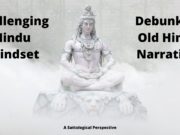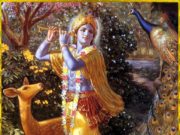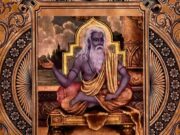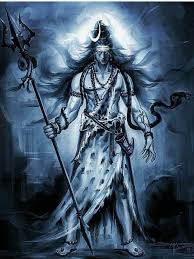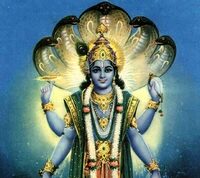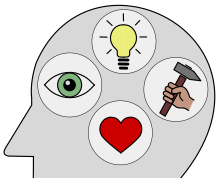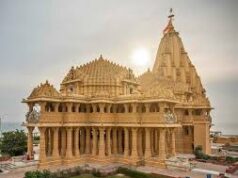ससर्जाग्रेऽन्धतामिस्रमथ तामिस्रमादिकृत् ।
महामोहं च मोहं च तमश्चाज्ञानवृत्तय: ॥ २ ॥
In the matter of creation, Brahma created new objects of nescience such as sense of death, anger arising out of frustration, bewilderment due to the sense of ownership, illusory bodily concept of life and even forgetfulness of one’s own real identity. Patanjali also concluded that there are five types of nescience. The creation subject is most comprehensively described only in Vedic literature. Most other literature outside the Vedic spectrum accept the creation concept with self doubt. They usually rely on modern scientists to hide their apparent lack of any revelation. That’s a very clever way to obfuscate a very pertinent inquisitive question.
Every human has a question on their origins. Most non-Vedic faiths silence that pertinent inquiry. And then they have the audacity to call Vedic scriptures as mythology. Where do Hindus draw a line ?
Brahma felt very sorry after creating nescience and considered his act of creation of nescience as ‘Paap’ (roughly meaning sinful). To absolve himself of the paap of creation of nescience, he purified himself by meditating on Bhagavan, Hari. To atone he started another part of creation. To counter nescience, he created four systems of knowledge. He produced four sons to take care of these four knowledge systems: Sanaka, Sananda, Sanatana and Sanat-kumar. They were responsible for Sankhya, Yoga, Vairagya and Tapas – the four systems of knowledge. But these four sons didn’t want to do anything with material knowledge or lifestyle. Why would they? It is naturally seen that men with such high acumen and realization tend to prefer a life of solitude in search of Vishnu. They declined their father’s request to create progeny. Naturally, they left home to see Vishnu, the only object of love in their life. That made their father, Brahma very frustrated and thereby angry. He couldn’t control his anger despite trying hardest.
धिया निगृह्यमाणोऽपि भ्रुवोर्मध्यात्प्रजापते: ।
सद्योऽजायत तन्मन्यु: कुमारो नीललोहित: ॥ ७ ॥
Despite trying his hardest to control anger, his anger came out of his body between his eyebrows, and a personalized form of anger notable in the hues of blue and red came out as a child. Many western scholars call this as a mythology because they just don’t know anything better. They conveniently use science when their theology fails while at other times conveniently rejecting science. In any case they neither have the theology and better still their science also has been plagiarized from Vedas. Therefore, Hindus must accept this history as a factual event based on the other aspects that have also been proved correct. The blue color represented (mode of ignorance) and the red (the mode of passion). When this child came out, he was crying incessantly asking Brahma to give him a name and a place.
स वै रुरोद देवानां पूर्वजो भगवान् भव: ।
नामानि कुरु मे धात: स्थानानि च जगद्गुरो ॥ ८ ॥
Brahma being a kind and compassionate father, pacified him and assured him with very kind words. He said, “I shall do what you desire.” Most Hindus are told that Puranas are not authentic and neither are Vedas. They are told that everything has been modified. But anyone who knows sanskrit knows that sanskrit is a Mathematical language. One change in one letter in sanskrit in Puran will lead to changes in everything else. Therefore, for the faithfuls, Puranas are an authority. Out of deep affection Brahma gave the name ‘Rudra’ to that child because he had so anxiously cried.
यदरोदी: सुरश्रेष्ठ सोद्वेग इव बालक: ।
ततस्त्वामभिधास्यन्ति नाम्ना रुद्र इति प्रजा: ॥ १० ॥
Then Brahma gave him the places of residence.
- Heart
- Senses
- Life air
- Sky
- Air
- Fire
- Water
- Earth
- Sun
- Moon
- Austerity
हृदिन्द्रियाण्यसुर्व्योम वायुरग्निर्जलं मही ।
सूर्यश्चन्द्रस्तपश्चैव स्थानान्यग्रे कृतानि ते ॥ ११ ॥
The anger is the root cause of a fall down of any living entity. That anger is controlled by this Rudra. Then Brahma gave these eleven names to Rudra.
मन्युर्मनुर्महिनसो महाञ्छिव ऋतध्वज: ।
उग्ररेता भव: कालो वामदेवो धृतव्रत: ॥ १२ ॥
Manyu, Manu, Mahinasah, Mahan, Siva, Rtadhvaja, Ugraretah, Bhava, Kalo, Vamdeva, and Dhritavrtah. These are referred to as eleven Rudra or eleven manifestations of Rudra. Then Brahma gave him eleven wives.
धीर्धृतिरसलोमा च नियुत्सर्पिरिलाम्बिका ।
इरावती स्वधा दीक्षा रुद्राण्यो रुद्र ते स्त्रिय: ॥ १३ ॥
Dhī, Dhṛti, Rasalā, Umā, Niyut, Sarpi, Ilā, Ambikā, Irāvatī, Svadhā and Dīkṣā.
गृहाणैतानि नामानि स्थानानि च सयोषण: ।
एभि: सृज प्रजा बह्वी: प्रजानामसि यत्पति: ॥ १४ ॥
Then, he gave him the instruction to increase the population as the master. Brahma as the loving father of Rudra, selected his wives and gave him a places of residence. Some followers of Rudra do not accept this narration by Brahma himself, however, Rudra himself confirms it in many other places when he calls Brahma as his father. The western scholars have no business in commenting anything on Vedic scriptures if they do not follow a tradition. Somehow due to their lack of faith and lack of knowledge of Sanskrit they engage in a lot of mental speculation which is suicidal for their own spiritual lives but also creates a philosophical disturbance in society. They inject their confusion and malicious abrahamic propaganda in the English translations of Vedic literature. Rudra created many offspring resembling himself in strength, body color and nature. They were in huge numbers, and they even tried to devour Brahma at one time. Brahma requested Rudra to produce offspring who are self controlled, and therefore he asked Rudra to engage in Tapa or austerities to bring happiness. Rudra was tasked to bring back his sons later during the time of dissolution. By worshipping Rudra we control our anger thereby bringing auspiciousness in our lives. Since Rudra performed Yoga under directions of Brahma, he is also known as Adi Yogi.
एवमात्मभुवादिष्ट: परिक्रम्य गिरां पतिम् ।
बाढमित्यमुमामन्त्र्य विवेश तपसे वनम् ॥ २० ॥
Rudra circumambulated his father Brahma keeping him on his right and entered the forest for Tapasya. Then, Brahma produced ten sons for the purpose of further creation.
मरीचिरत्र्याङ्गिरसौ पुलस्त्य: पुलह: क्रतु: ।
भृगुर्वसिष्ठो दक्षश्च दशमस्तत्र नारद: ॥ २२ ॥
Puranas are not mythology. The Puranas stories match with Vedas in terms of spiritual conclusions. A sincere follower of Veda must refer not only to the Vedas, but also to the purāṇas. One should not foolishly consider the Purāṇas mythological. If they were mythological, Śukadeva Gosvāmī would not have taken the trouble to recite the old historical incidents concerning the life of Ajāmila.
Brahma-yāmala:
śruti-smṛti-purāṇādi-
pañcarātra-vidhiṁ vinā
aikāntikī harer bhaktir
utpātāyaiva kalpate
“Bhakti that ignores the authorized Vedic literatures like the Upaniṣads, Purāṇas and Nārada-pañcarātra is simply an unnecessary disturbance in society.”
The Gita: Sattology
by Amazon.com Services LLC
Om Namah Shivay
Disclaimer: The views are personal to the author based on his research.


